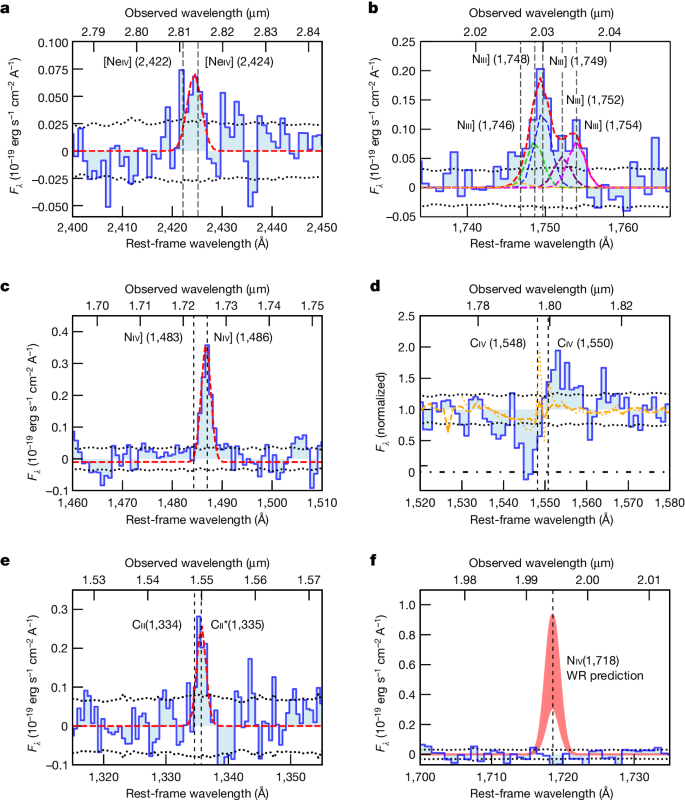2024-03-04 NASA
<関連情報>
- https://science.nasa.gov/missions/webb/webb-unlocks-secrets-of-one-of-the-most-distant-galaxies-ever-seen/
- https://arxiv.org/abs/2306.00953
- https://www.nature.com/articles/s41586-024-07052-5
JWST-JADES。GN-z11のハローにおけるz=10.6での人口IIIシグネチャの可能性 JWST-JADES. Possible Population III signatures at z=10.6 in the halo of GN-z11
Roberto Maiolino, Hannah Uebler, Michele Perna, Jan Scholtz, Francesco D’Eugenio, Callum Witten, Nicolas Laporte, Joris Witstok, Stefano Carniani, Sandro Tacchella, William Baker, Santiago Arribas, Kimihiko Nakajima, Daniel Eisenstein, Andrew Bunker, Stephane Charlot, Giovanni Cresci, Mirko Curti, Emma Curtis-Lake, Anna de Graaff, Zhiyuan Ji, Benjamin D. Johnson, Nimisha Kumari, Tobias J. Looser, Michael Maseda, Brant Robertson, Bruno Rodriguez Del Pino, Lester Sandles, Charlotte Simmonds, Renske Smit, Fengwu Sun, Giacomo Venturi, Christina Williams, Christopher Willmer
arXiv last revised:3 Jun 2023
DOI:https://doi.org/10.48550/arXiv.2306.00953

ABSTRACT
Finding the first generation of stars formed out of pristine gas in the early Universe, known as Population III (PopIII) stars, is one of the most important goals of modern astrophysics. Recent models suggest that PopIII stars may form in pockets of pristine gas in the halo of more evolved galaxies. Here we present NIRSpec-IFU and NIRSpec-MSA observations of the region around GN-z11, an exceptionally luminous galaxy at z=10.6, which reveal a >5σ detection of a feature consistent with being HeIIλ1640 emission at the redshift of GN-z11. The very high equivalent width of the putative HeII emission in this clump (170 A), and the lack of metal lines, can be explained in terms of photoionisation by PopIII stars, while photoionisation by PopII stars is inconsistent with the data. It would also indicate that the putative PopIII stars likely have a top-heavy initial mass function (IMF), with an upper cutoff reaching at least 500 M⊙. The PopIII bolometric luminosity inferred from the HeII line would be ∼2×1010 L⊙, which (with a top-heavy IMF) would imply a total stellar mass formed in the burst of ∼6×105 M⊙. We find that photoionisation by the Active Galactic Nucleus (AGN) in GN-z11 cannot account for the HeII luminosity observed in the clump, but can potentially be responsible for additional HeII emission observed closer to GN-z11. We also consider the possibility of in-situ photoionisation by an accreting Direct Collapse Black Hole (DCBH) hosted by the HeII clump; we find that this scenario is less favoured, but it remains a possible alternative interpretation. We also report the detection of a Lyα halo stemming out of GN-z11 and extending out to ∼2 kpc, as well as resolved, funnel-shaped CIII] emission, likely tracing the ionisation cone of the AGN.
宇宙初期の小さくて元気なブラックホール A small and vigorous black hole in the early Universe
Roberto Maiolino,Jan Scholtz,Joris Witstok,Stefano Carniani,Francesco D’Eugenio,Anna de Graaff,Hannah Übler,Sandro Tacchella,Emma Curtis-Lake,Santiago Arribas,Andrew Bunker,Stéphane Charlot,Jacopo Chevallard,Mirko Curti,Tobias J. Looser,Michael V. Maseda,Timothy D. Rawle,Bruno Rodríguez del Pino,Chris J. Willott,Eiichi Egami,Daniel J. Eisenstein,Kevin N. Hainline,Brant Robertson,Christina C. Williams,… Fengwu Sun
Nature Published:17 January 2024
DOI:https://doi.org/10.1038/s41586-024-07052-5

Abstract
Several theories have been proposed to describe the formation of black hole seeds in the early Universe and to explain the emergence of very massive black holes observed in the first thousand million years after the Big Bang1,2,3. Models consider different seeding and accretion scenarios4,5,6,7, which require the detection and characterization of black holes in the first few hundred million years after the Big Bang to be validated. Here we present an extensive analysis of the JWST-NIRSpec spectrum of GN-z11, an exceptionally luminous galaxy at z = 10.6, revealing the detection of the [NeIV]λ2423 and CII*λ1335 transitions (typical of active galactic nuclei), as well as semi-forbidden nebular lines tracing gas densities higher than 109 cm−3, typical of the broad line region of active galactic nuclei. These spectral features indicate that GN-z11 hosts an accreting black hole. The spectrum also reveals a deep and blueshifted CIVλ1549 absorption trough, tracing an outflow with velocity 800−1,000 km s−1, probably driven by the active galactic nucleus. Assuming local virial relations, we derive a black hole mass of log(MBH/M⊙)=6.2±0.3, accreting at about five times the Eddington rate. These properties are consistent with both heavy seeds scenarios and scenarios considering intermediate and light seeds experiencing episodic super-Eddington phases. Our finding explains the high luminosity of GN-z11 and can also provide an explanation for its exceptionally high nitrogen abundance.



